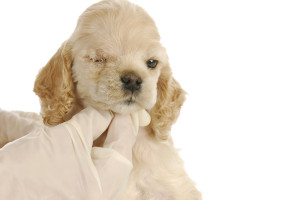There are many diseases and ailments involving the canine eye. However, some are more prevalent than others, and it is likely you will deal with at least one of these five at some point during your dog’s life. Knowing the signs can speed up treatment and in some cases prevent the disease from getting worse.
1. Conjunctivitis
This may be the most common eye ailment that most dogs get at one time or another in their life. It is an infection of the tissue that covers the front part of the eyeball and lines the eyelids. Signs are a red, swollen eye with discharge. It’s irritating for the pet, but not usually painful.
There are 3 types of conjunctivitis – serous (clear discharge), mucoid (mucus-like discharge), purulent (pus-like discharge) — and sometimes a more serious disease (keratitis, uveitis or glaucoma) can be mistaken for it, so you should take your dog to the vet to be sure. If your dog has the mildest type, serious, it can be treated at home with daily eye flushings, the other two require antibiotics. Regardless of type, you should work with your vet to determine the cause to prevent future inflammations. If left untreated, severe conjunctivitis can cause blindness (www.webmd.com).
2. In-Growing Eyelids
Just like it sounds, dogs with this problem have eyelids that curl under so that that the lashes are rubbing against the cornea. Obviously this is a painful and irritating problem, which can cause damage to the dog’s eye. Surgery is needed to correct the problem, which should be done as soon as possible to prevent further damage.
3. Prolapse of the Third Eyelid
Known commonly as “cherry eye” this eye problem creates a bulging pink mass in the corner of the dog’s eye. According to Wendy C. Brooks, DVM DipABVP, vets used to just remove the prolapsed gland. However, this causes a condition called “dry eye” and the dog will end up going blind. The only way to treat it successfully is to replace the gland. (www.veterinarypartner.com)
This is a genetic trait that is common in English bulldogs, cocker spaniels Boston terriers, beagles, etc. There are complications associated with the surgery so be sure to talk to your vet and see a specialist if necessary.
4. Cataracts
Like cherry eye, most cases of cataracts are inherited. However, diabetes, old age, electric shock, inflammation of the eye’s uvea, low levels of calcium in the blood, or exposure to radiation/toxic substances can also cause it.
Cataracts is noticeable due to the cloudiness in the dog’s eye(s). Up to 30 percent opacity, your dog can still see. Anything over 60 percent and your dog will suffer loss of vision. (www.petmd.com).
Surgery can be an option depending on how severe the cataract is; since it’s an expensive and invasive surgery, it is not usually performed unless it will restore sight or relieve pain (www.veterinarypartner.com).

5. Glaucoma
Dogs that have this eye disease have increased pressure within the eye. It is probably the most painful of the eye ailments and leads to blindness. There are two types of glaucoma: primary and secondary. Primary is caused by the eye’s inability to drain, while secondary glaucoma is due to an eye infection.
Secondary glaucoma is why it is VITAL you take your dog to the vet if you believe she may have an eye infection. What may seem simple at first, can turn into something serious. Let it go, and your dog could face BLINDNESS.
Your dog’s eyes are important. Watch for any redness, swelling, discharge, discomfort, itching, cloudiness or dryness and go to the vet at the first sign of a problem. When choosing a dog, ask about eye problems in the lines and the breeding dogs should have test results stating they are clear of any heredity diseases common with that breed.
About the Author
Based in Tustin, Calif., animal lover Kristina N. Lotz is a Certified Professional Dog Trainer – Knowledge Assessed (CPDT-KA) and works as a full time trainer. She also owns her own custom pet products company, A Fairytail House, where she makes personalized collars, leashes, beds, keepsake pillows and blankets, and anything else your imagine can think up. In her spare time, she trains and competes in herding, agility, obedience, rally, and conformation with her Shetland Sheepdogs.

